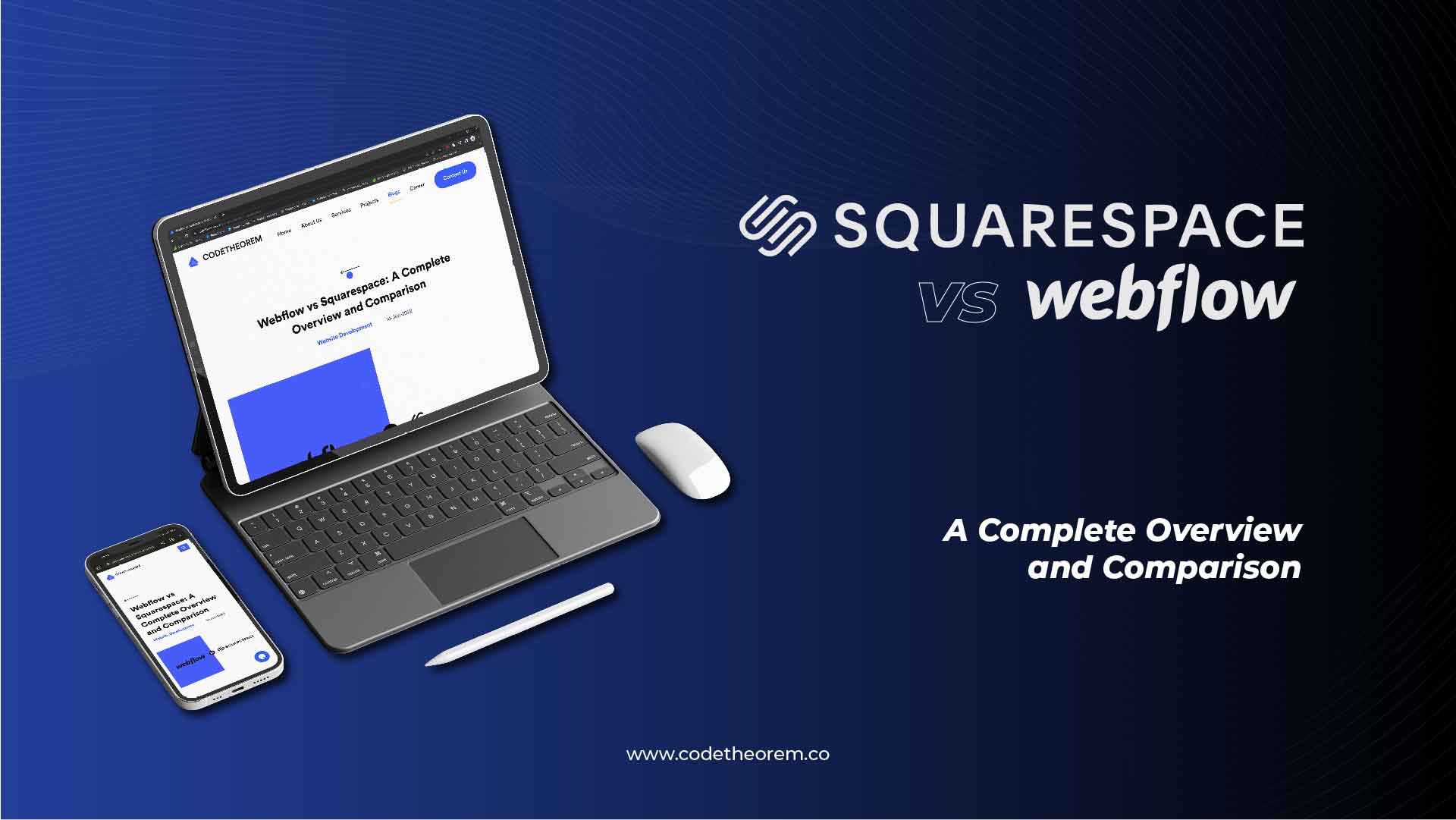When you look online, plenty of hosting and website building solutions are out there. But, two that stand out as particularly good and easy to use are Squarespace and Webflow. Webflow vs Squarespace is a tough match-up. They both offer a variety of attractive templates, easy-to-use interfaces, and a range of powerful features. They provide the power to create beautiful websites without any coding knowledge.
According to the Zapier report, 90% of no-code users have reported that their company has been able to grow faster because of their no-code usage. It makes the platforms more effective for improving a future growth strategy.
However, this also means that there are some key differences between the services, making it difficult to choose between them.
So, we’ll be looking at Squarespace vs Webflow, and what makes each one unique so that you can make the right choice for your needs.
Article content
What is Squarespace?
Basics first. What is Squarespace? Squarespace is a website builder that allows users to build beautiful websites without the hassle of learning how to code. It’s perfect for any individual or business looking to grow its online presence.
The websites are customizable, and users can choose from many free templates to build their websites. Squarespace also offers a free domain when you sign up for a year.
What is Webflow?
Webflow is a website builder that allows you to build and launch responsive websites without writing code. It’s known as a “drag-and-drop” design platform, and it uses a visual interface rather than a text editor to help you create your site.
You can edit it, add new pages, and update it as often as possible. Webflow is a little different from traditional website builders and online services. You can skip creating a website by marking up plain text in a text editor and then publishing it on a server. All you need to do is build your website using the Webflow interface. It’s the best of both worlds: a website builder’s easy-to-use interface and a coding environment’s powerful features.
Squarespace’s Main Features
Squarespace is an all-in-one website solution that improves how you interact with your website. It provides you with various options for making the most of it.
Squarespace offers the following features:
- A drag and drop page builder with pre-built layouts and customizable templates.
- You can integrate all social media and run various marketing campaigns, including email and newsletter marketing.
- It lets you use third-party tools and extensions related to sales, finance, marketing, inventory, shipping, etc.
- Built-in analytics tools help you track site traffic, sales, popular content, and more.
- You can connect third-party domains with Squarespace and do Google workspace integration.
- Use an SEO link builder tool to optimize your site for search engines.
- Create galleries to showcase your work or special pieces of content on your site.
- Manage all content on the go via the mobile app.
Webflow’s Core Features
Webflow is an all-in-one web design platform that allows anyone to build and maintain a website or app without technical skills. The software has an easy-to-use interface, making it perfect for beginners and professionals. Webflow’s core features include:
Webflow’s core features are:
- Design fully responsive websites from scratch with customizable templates.
- Create, edit, and synchronize the CSS for each page.
- Build with the same code that runs in the browser and the editor.
- Use all HTML5 elements, including canvas and web fonts.
- Develop your site in your browser without uploading it.
- Use dynamic page elements (like scrolling sections) to create responsive, user-friendly pages.
- Customizable navigation menus (use text or image buttons).
Comparison: Webflow vs Squarespace
Webflow vs Squarespace: Ease Of Use
Ease of use is a significant selling point in Webflow vs Squarespace. Both options are good if your website doesn’t need much customization or functionality. In essence, the main difference in ease of use between Webflow vs Squarespace is how far you can take your website’s design.
Squarespace
Squarespace templates are more customizable than Webflow’s. You can add a header image that extends across the top of your whole site and within your Squarespace templates.
Webflow
While you can customize colors and fonts on Webflow, there aren’t as many options to customize the look of each template. Webflow only lets you add an image header to individual pages. You can drag and drop HTML into Webflow themes and style them. There are no webflow plugins. But, you can still add new features via code snippets.
Webflow vs Squarespace: Marketing And SEO Tools
Online marketing has become a necessity for businesses of any size. The tools at your disposal have evolved to include channels such as social media, blogs, and SEO (search engine optimization).
Webflow and Squarespace provide the following features in their basic plans:
- Adding alt tags to images
- Mobile optimization
- Auto-generated sitemaps
- Social media handles linked to the website
Alt tags are an HTML attribute used to describe images on a webpage. A sitemap is a file that you create and submit to search engines for them to index all the content on your site. It contains information about every web page on your site.
When it comes to advanced plans, both tools have much to offer:
Squarespace
Squarespace SEO provides a checklist of best practices to display and deliver your content in the best way possible. The Google search console integration gives you detailed data on the Squarespace SEO dashboard. It helps you see metrics like impressions, clickthroughs, position on the search results page, and more.
Webflow
Many Webflow SEO tools integrate the website with tools like Google Analytics, Mailchimp, Salesforce, and more. Webflow SEO and marketing tools could be excellent tools to streamline your efficiency. In conclusion, they help you work with other teams instead of inundating you with tasks via email, etc.
Webflow vs Squarespace: Design Flexibility
Squarespace
Squarespace has many features, like fantastic drag-and-drop page building and social media integration. But, it’s not as strong when it comes to customizing the look and feel of your site without writing code. There are 110+ free Squarespace theme templates. People will want more freedom over every aspect of their site’s appearance, which Squarespace lacks.
Webflow
Webflow offers a lot more freedom for designers to create sites exactly how they want them. The Webflow themes are beautiful and open-ended, making them easier to work through.
You have the option to embed custom HTML, CSS, or JavaScript code with Webflow. When working on a responsive design, you will find countless breakpoints to go through and edit, which is quite time-consuming. But don’t worry! You can build with seven different breakpoints, so it’s just as quick and easy to customize your Webflow themes’ design as it may be necessary.
Webflow vs Squarespace: Blogging Features
Squarespace
Squarespace supports rich blog features like comments for multiple authors, allows post scheduling, and has AMP (Accelerated Mobile Posts) support. You can integrate your Squarespace site with Leads Pages or MailChimp and use the mobile app to see your content on the go. Also, you can organize a podcast from inside the platform to focus on what matters: creating great content.
Webflow
Webflow offers a fantastic solution for keeping your blog up-to-date. You can design it to your unique specifications and schedule posts so that they appear automatically when they’re due.
But, getting extra features such as comment functionality to work requires a bit of tinkering. You need to configure them manually, which usually involves patching a few bits of code together.
Webflow vs Squarespace: Apps and Integrations
Squarespace
Squarespace has an app marketplace with 24 apps integrated with the site builder. The compilation of these powerful additions sets Squarespace apart from the rest. If there’s one thing to say about Squarespace, the integrations are incredibly well-designed and easy to use. They don’t feel like a last-minute addition; instead, they’re simply part of what you get when using this platform.
Webflow
Webflow is harder to use than Squarespace, even though it provides more advanced features and integration options. It has built-in integrations for hundreds of different products, which you can add with one click. Yet, it requires your website development team to do a little work to do this integration manually. Hence, it’s much more complicated than installing extensions on Squarespace.
Having looked at Webflow and Squarespace, if you’re looking for a builder with countless integrations, then you’re better off with Webflow. That said, Squarespace shines in the quality of its integrations. They are seamless and come pre-made, so all that’s left is to choose which one you want for your website and drag and drop it onto your new homepage.
Webflow vs Squarespace: Pricing and Value For Money
| Webflow | Squarespace | |
|---|---|---|
| Free plan/trial? | Free plan | A free trial (14 days) |
| Price range | $12 – $212/month | $12 – $40/month |
| Best for | Tech-savvy users who plan on growing a lot | Creative and entrepreneurial types who want some tech support. |
Squarespace
Squarespace pricing is flexible. You can get a free custom domain name with a Squarespace price plan of $14/ month and unlimited bandwidth.
Squarespace plans are pretty simple—it’s all about their basic plan, which starts at $14/month and goes up to $49/month depending upon your requirements. Additionally, the Squarespace plans offer some add-ons like eCommerce, domain privacy protection, and other things Webflow doesn’t offer.
Webflow
Webflow pricing has an annual plan with extra features, starting at $12/month. The Webflow plans range from $12-$74/month. However, the best value in Webflow pricing comes in the Business Plan ($36/month), which includes features required to scale your business globally.
That said, if you favor flexibility and want to design your website how you like it, then advanced Webflow plans may be worth the money. Take the Webflow eCommerce pricing plan at $74/month. The Webflow plans cost more than the advanced Squarespace price at $49/month. But, you’ll get some more serious features that enhance your sales process and help your business grow, such as:
- $200k yearly sales volume
- Up to 10 admin accounts
- Custom code
Webflow vs Squarespace: Performance And Security
According to the Portent report, the most optimal browsing experience occurs when web pages load within 3 seconds (in general). When comparing Squarespace vs Webflow load times, it took 2.4 s for Webflow and 2.8 s for Squarespace. Both website builders did a splendid job of accomplishing that goal.
On top of these excellent results, it takes them less than 1.5 seconds to load the top section of each website. It’s even better than the minimum recommendation.
When it comes to security, there are two layers of protection – uptime and backups.
Uptime
Uptime is the amount of time that your website is up and running. Both Squarespace and Webflow offer 99.9% uptime (or better), translating to less than nine hours of downtime each year. But, you can expect even less downtime because both platforms have set an ambitious goal to achieve maximum availability.
Backups
It’s always a good idea to have a backup of your website saved, especially if things go wrong. Squarespace doesn’t automatically save your work when you’re editing your site. However, the editor stores backup copies on primary and secondary servers and lets you restore pages for up to 30 days after you delete them.
Webflow saves a copy of your work on their servers automatically and can help you restore any previous versions of your website up to the last two. In addition, you can create unlimited backups on the CMS plan.
Webflow vs Squarespace: Webflow Business And eCommerce Features
Webflow is not just a website hosting and development platform. The Webflow eCommerce suite allows you to deal with all items and orders. While there are reasonable $29 and $74 subscription fees, they are worth the cost, given how much time it saves in product development.
It allows for specific customized variables within each product, such as price, description, and category. Webflow will surely meet all your product management needs. It lets you make the following changes:
- Add new items with multiple variants.
- Sell both physical items and digital products or services.
- Enable inventory tracking.
- Set shipping options for each product.
After that, the editor can see orders, set discounts, manage products, and manage the website like an eCommerce platform.
A shortcoming of this builder is that it allows 10,000 content management system (CMS) items that you can post online. CMS items are generally the number of records or pieces of information stored at one time in a particular database. For a blogging website, it can be different content types, whereas, for an e-commerce website, it can be products and categories.
You might run out of room quickly if you’re looking to put up multiple articles or too many products each day.
If you run an online blog, you must know what SEO changes you can make without help from additional software. They are critical to your site and require proper implementation. Some general SEO features that the builder provides include:
- Enable auto-generated sitemap
- Set a global canonical URL
- Set custom SEO settings for each product, page, and category.
- Create and manage forms and mailing lists for email campaigns
Webflow vs Squarespace: Squarespace Business And eCommerce Features
Squarespace eCommerce helps you by guiding you every step as you set up your new business and build upon it to make it even more successful for years to come. Your website-building tools are available on the dashboard directly from the central location, where it collects all of your information.
Squarespace has 110+ different website templates available to its customers. These website templates have 6 categories, and you can find different Squarespace eCommerce store templates organized in the Online Stores category. Also, you can use a template from any other category on your Squarespace site.
Top e-commerce features that’ll help you scale your online business that Squarespace provides include:
- Product management – This Squarespace app allows you to sell things online by creating categories, scheduling products for sale, and managing inventory.
- Payment and shipping options – Your customers have more than one option for how to pay for the products or services you offer, and you can choose which shipping gateway is best for them.
- Types of products –Selling products online has never been so easy. Let Squarespace do the heavy lifting for you if you sell a physical product or your services.
- Point of sale – This feature is great for sellers with both online and physical stores. Squarespace gives you a centralized database for all your products that you can easily access.
- App store – Most apps are in-house and free. But, some great third-party plugins are available on the Squarespace marketplace if you’re looking to add even more customization to your site.
Webflow vs Squarespace: Switching Process
There’s not much difference in the switching process in Webflow vs Squarespace. Moving your existing site to Squarespace or Webflow requires a bit of work. You’ll have to move your content over manually. There is no automated importation tool in place. Also, you’ll need to reupload the images.
Both Squarespace and Webflow use a no-code layout, making it easier for you to get your website up and running quickly. Once you understand the workarounds, it will be easy to upload things at a rapid pace.
Conclusion
In the duel of Squarespace vs Webflow, Squarespace is preferable when it comes to ease of use and value for money compared to its wide variety of templates. As a beginner or someone looking for a more straightforward solution, consider using Squarespace. However, Webflow offers a good option for those who want to create their website design from scratch. You’ll likely be able to have freedom over the entire design, which is a plus point. Thus, weigh webflow and squarespace pros and cons before making a final decision.


















